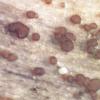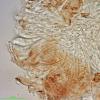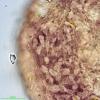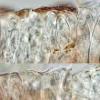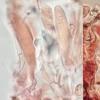
12-11-2025 09:25
 Viktorie Halasu
Viktorie Halasu
Hello, I need help with a pale terrestric Pseudom

11-11-2025 20:16
Bohan JiaHi, lastly I have found these tiny yellow decayin

09-11-2025 13:20
Hello.A tiny ascomycete, appearing as erupting gra

08-11-2025 00:29
 Francois Guay
Francois Guay
I found this species in Quebec, Canada, on herbace

04-11-2025 09:07
Hello.A suspected Hymenoscyphus sprouting on a thi
The disks are sessile, 80-200 µm wide, with a darker slightly raised margin. The exciple is covered with a crust covering everything and preventing a view of what is behind. A similar crust is in part also covering the hymenium (pseudoepithecium?). Asci eight-spored, 32-55 × 5.9-7.3 µm, the bases are so agglutinated that I dont't know about croziers, negative in Lugol with and without pretreatment. The spores are 7.0-8.0 × 2.6-2.9 µm, with a few small guttules at each end. The parafyses are slighly clavate, 3.0-4.2 µm at apex and unfortunately so easily dying that I can't say anything about their contents.
I can't find a Micropeziza with such small spores - or is it something else?

But I think I found some living parafyses. They have a not very refractive guttule at the apex. They are very sensitive to pressure - as soon as I touch the cover slip they are mostly gone.
The crust of my fungus is very similar to the the one on photo "Durella, II.2014-2" in the Skyttea folder.

Thank you, I suppose this is as far as it is possible to get with morphology alone.


